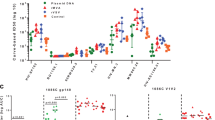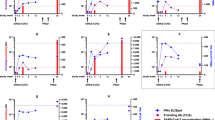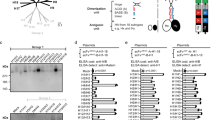Abstract
Viral infection and vaccination with DNA both induce similar immune responses to encoded antigens that are produced by the host1,2. The availability of antigens in lymphoid organs is important in generating an immune response to viral challenge3. Antigen availability may also be important in the response to DNA vaccines, because immune responses are stronger when antigen is secreted from DNA-transfected cells4,5. We directed antigen to lymphoid organs by vaccination with DNA encoding antigen–ligand fusion proteins. The two ligands examined bind to receptors that are present on high endothelial venule cells of lymph nodes or on antigen-presenting cells. Here we show that both the humoral and the cellular immune responses to a model DNA vaccine were enhanced using either antigen-targeting strategy. Moreover, directing antigen to antigen-presenting cells speeded up, and altered the form of, the immune response. Directing antigen to sites of immune-response induction may represent a generic means of tailoring a potent and effective immune response to a DNA vaccine.
This is a preview of subscription content, access via your institution
Access options
Subscribe to this journal
Receive 51 print issues and online access
$199.00 per year
only $3.90 per issue
Buy this article
- Purchase on Springer Link
- Instant access to full article PDF
Prices may be subject to local taxes which are calculated during checkout



Similar content being viewed by others
References
Ulmer, J. B. et al. Heterologous protection against influenza by injection of DNA encoding a viral protein. Science 259, 1745–1749 (1993).
Raz, E. et al. Intradermal gene immunization: the possible role of DNA uptake in the induction of cellular immunity to viruses. Proc. Natl Acad. Sci. USA 91, 9519–9523 (1994).
Karrer, U. et al. On the key role of secondary lymphoid organs in antiviral immune responses studied in alymphoplastic (Aly/Aly) and spleenless (Hox11(−/−)) mutant mice. J. Exp. Med. 185, 2157–2170 (1997).
Boyle, J. S., Koniairas, C. & Lew, A. M. Influence of cellular location of expressed antigen on the efficacy of DNA vaccination: cytotoxic T lymphocytes and antibody respones are sub-optimal when antigen is cytoplasmic after intramuscular DNA immunization. Int. Immunol. 9, 1897–1906 (1997).
Inchauspe, G. et al. Plasmid DNA expressing a secreted or a nonsecreted form of hepatitis C virus nucleocapsid: comparative studies of antibody and T-helper respones following genetic immunization. DNA Cell Biol. 16, 185–195 (1997).
Arbones, M. L. et al. Lymphocyte homing and leukocyte rolling and migration are impaired in L-selectin-deficient mice. Immunity 1, 247–260 (1994).
Catalina, M. D. et al. The route of antigen entry determines the requirement for L-selectin during immune responses. J. Exp. Med. 184, 2341–2346 (1996).
Linsley, P. S., Clarke, E. A. & Ledbetter, J. A. T-cell antigen CD28 mediates adhesion with B cells by interacting with activation antigen B7/BB-1. Proc. Natl Acad. Sci. USA 87, 5031–5035 (1990).
Mor, G. et al. Complexity of the cytokine and antibody response elicited by immunizing mice with Plasmodium yoelii circumsporozoite protein plasmid DNA. J. Immunol. 155, 2039–2046 (1995).
Michel, M. L. et al. DNA-mediated immunization to the hepatitis B surface antigen in mice: aspects of the humoral response mimic hepatitis B viral infeciton in humans. Proc. Natl Acad. Sci. USA 92, 5307–5311 (1995).
Snapper, C. M. & Mond, J. J. Towards a comprehensive view of immunoglobulin class switching. Immunol. Today 15, 15–17 (1993).
Linsley, P. et al. Immunosuppression in vivo by a soluble form of the CTLA-4 T cell activation molecule. Science 257, 792–795 (1992).
Lenschow, D. J. et al. Long-term survival of xenogeneic pancreatic islet grafts induced by CTLA4Ig. Science 257, 789–792 (1992).
Wolff, J. A. et al. Direct gene transfer into mouse muscle in vivo. Science 247, 1465–1468 (1990).
Johnson, K. S. et al. Vaccination against ovine cysticercosis using a defined recombinant antigen. Nature 338, 585–587 (1989).
Xiang, Z. & Ertl, H. C. Manipulation of the immune response to a plasmid-encoded viral antigen by coinoculation with plasmids expressing cytokines. Immunity 2, 129–135 (1995).
Lew, A. M., Brady, J. L., Silva, A., Coligan, J. E. & Georgiou, H. M. Secretion of CTLA4Ig by an SV40 T antigen transformed islet cell line inhibits graft rejection against the neoantigen. Transplantation 62, 83–89 (1996).
Boyle, J. S., Silva, A., Brady, J. L. & Lew, A. M. DNA immunization: induction of high avidity antibody and effect of route on T cell cytotoxicity. Proc. Natl Acad. Sci. USA 94, 14626–14631 (1997).
Aida, Y. & Pabst, M. J. Removal of endotoxin from protein solutions by phase separation using Triton X-114. J. Immunol. Meth. 132, 191–195 (1990).
Acknowledgements
We thank J. F. A. P. Miller and L. C. Harrison for help in preparing this manuscript, and W. R. Heath, R. M. Sutherland, D. M. Tarlinton, D. Drew and R. Strugnell for helpful discussions. This work was supported by NH and MRC of Australia, Appel Estate, Diabetes Australia and a JDFI-NIH grant.
Author information
Authors and Affiliations
Corresponding author
Rights and permissions
About this article
Cite this article
Boyle, J., Brady, J. & Lew, A. Enhanced responses to a DNA vaccine encoding a fusion antigen that is directed to sites of immune induction. Nature 392, 408–411 (1998). https://doi.org/10.1038/32932
Received:
Accepted:
Issue Date:
DOI: https://doi.org/10.1038/32932
This article is cited by
-
Design of a novel multiepitope vaccine against Chlamydia pneumoniae using the extracellular protein as a target
Scientific Reports (2023)
-
Fusion with extracellular domain of cytotoxic T-lymphocyte-associated-antigen 4 leads to enhancement of immunogenicity of Hantaan virus DNA vaccines in C57BL/6 mice
Virology Journal (2011)
-
Antigen fusion with C3d3 augments or inhibits humoral immunity to AAV genetic vaccines in a transgene‐dependent manner
Immunology & Cell Biology (2010)
-
Equivalent stimulation of naive and memory CD8 T cells by DNA vaccination: a dendritic cell‐dependent process
Immunology & Cell Biology (2009)
-
Antigen-specific humoral tolerance or immune augmentation induced by intramuscular delivery of adeno-associated viruses encoding CTLA4-Ig-antigen fusion molecules
Gene Therapy (2009)
Comments
By submitting a comment you agree to abide by our Terms and Community Guidelines. If you find something abusive or that does not comply with our terms or guidelines please flag it as inappropriate.



